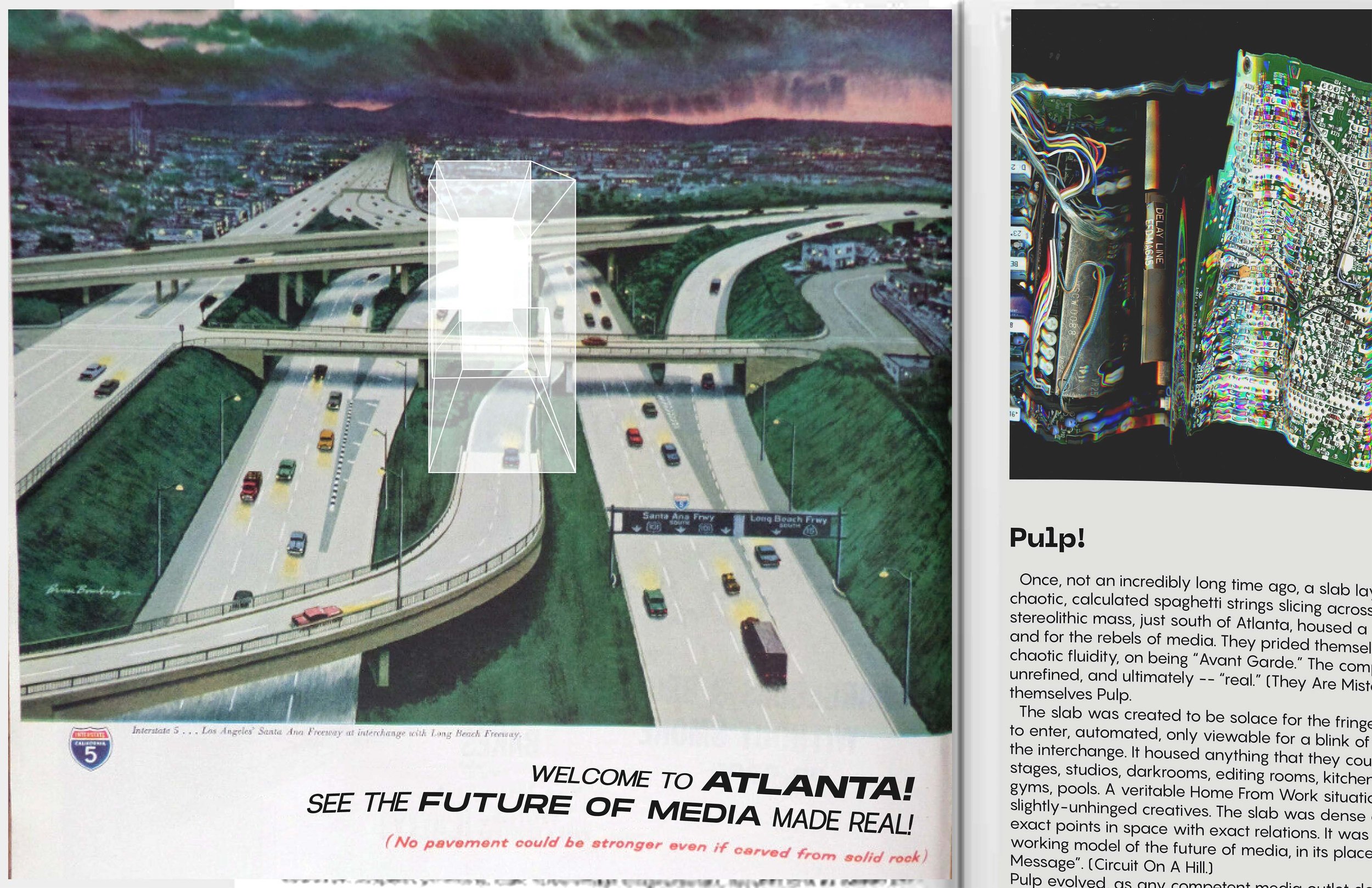Pulp!
When a machine system is properly calibrated to understand its position in physical space, the digital can be commingled with physical space. This is the driving principle behind the modern film studio, where empty expanses are critical assets… Behind these filmic apparitions actors in motion-capture suits perform in front of the green-screen structures adorned with black crosshairs and calibration markers. Modern film studios constitute an architecture stripped bare, a mere scaffold or infrastructure for a digitally constructed world.^1
^1 Young, Liam, “An Atlas of Fiducial Landscapes: Touring The Architectures Of Machine Vision.” In Log, no. 36 (2016): 130.
The non-relevance of physical space, and the oblique necessity of it, offers an awkward handshake between fingers and wires. The most lucrative entertainment franchises stand on the shoulders of hybrid multimedia production. Hyper-flexibility, within both tangible and digital mediums, allow these institutions to dominate global attention. Blockbuster behind-the-scenes footage of a caped man suspended in a warehouse of green, awaiting CGI environments cobbled together in post-production—ad infinitum.
As digital technologies increasingly extend into the physical world, using it as a fiducial landscape to prop up digitally constructed environments, ethical questions are brought to the surface. Entertainment applications like Pokémon GO overpaint our physical world of sidewalks and parks as riddled with mythical creatures. Further infrastructural applications, like Google Maps, have animated our transportation rhythms, focusing our attention away from road signs and toward a handheld, constantly updating digital interface. Tech developers may soon ask: is it not simpler for the eye to highlight the route forward rather than glancing down at the navigation app open in the passenger seat? While most digitally augmented experiences remain novel, eventually there comes a point where the update of surreally superimposed landscapes are prioritized over maintenance of the literal. Concurrent physical and digital stimuli force the individual to comprehend many—often divergent—truths. The overlaid material and digital realities will slowly blur to the point where one is indiscernible from the other. The material plane will not be left vacuous of fundamental substance, but instead comprehensive existence will be integrated with the digitally augmented gaze.
00. Witness A New Age Spectacle!
PULP! is a new book of a lost holy scripture. It is a fanciful text of a media apparatus binding digitization with physicality to the point of absolute integration. Equally an idyllic playground and an idiotic hellscape. It is a multiplane of stark losslessness joined at the hip with profound desolation. PULP! is awful, incredible, immanent:
01. A Company Dedicated To Comprehensive Production
Once, not an incredibly long time ago, a slab lay in a no-mans-land of calculated, densely entangled veins which sliced across the landscape. This stereolithic mass, just south of Atlanta, housed a production conceived by and for those brave renegades of media. They prided themselves on operating with chaotic fluidity, on being “Avant Garde.” Their aim was to be a mirror of the highways that ensnared them. The company was raw, agile, unrefined, and ultimately, “real.” (An Effortless Mistake To Make). They christened their endeavor PULP!
02. Where Would You Rather Be Planted?
The slab was created as a place of solace—difficult to enter, automated, and only viewable for a blink of an eye while navigating the interchange. Their stronghold protected anything that they could ever want—sound stages, darkrooms, editing rooms, kitchens, cafes, apartments, gyms, pools, cost be damned (whatever investor these maniacs found must have been benevolent). It was a veritable Home-From-Work contrivance for busy, dedicated, slightly-unhinged creatives. Caffeine bloodstreams committed to a rectilinear tributary in southern heat. The slab was densely built and impossibly complex, conferring exact points in space with exact relations. It was intended to be the working model of the future of media, crowned in its societal place as “The Message” (The Light Of The New World. A Circuit Upon A Hill Cannot Be Hidden).
PULP! evolved frequently, as any competent media outlet does, and found that their glorious slab wasn’t all that it was designed to be. (It Is A Capital State Of More.) The slab was recurrently new. It was made of and built for itself, entirely – solely. The boundaries were placed delicately and where needed, “delineating but never separating,” the architects proclaimed – walls and floors left easily remappable by the codemasters of the building. As the media landscapes around the company changed, so too did relationships between its organs and their spaces.
The slab continuously evolved as production saw fit, a microcosm of dizzying and overcycling production rhythms. “May we only become more efficient,” the plaques read. Emphasis on coded logics would swell…
…read more Pulp! in Issue 31.
Owen Caraway is an artist focused on anachronism and juxtaposition to explore mundane absurdity in the relationships of things. Through manipulation of any and all mediums there appears to be no fixed subject to his work; rather an inherent enjoyment of the world and working to interpret its latent comedy. Influences range from Camus to Burnett to Eco to Hillenburg. He is a graduate of the UNCC College of Art and Architecture. Several works of little importance have been displayed in various local shows.
Lucas Gillie is an architectural designer interested in all things temporality, commingling of digital and physical spaces, sci-fi, and short, expansive boxes. His work seeks to establish a dialogue between memory, fantasy, and representation to further examine time in the context of architecture. He prefers: to raise questions rather than offer solutions; to go on a tangent rather than remain loyal to a subject; to have something on the tip of his tongue rather than a coherent thought. He has published nothing nor presented his work anywhere. He is a graduate of the University of North Carolina at Charlotte, Ravin School of Architecture (B.A. in Architecture ‘22) and is a graduate student at the Yale School of Architecture (M.Arch ‘26).


